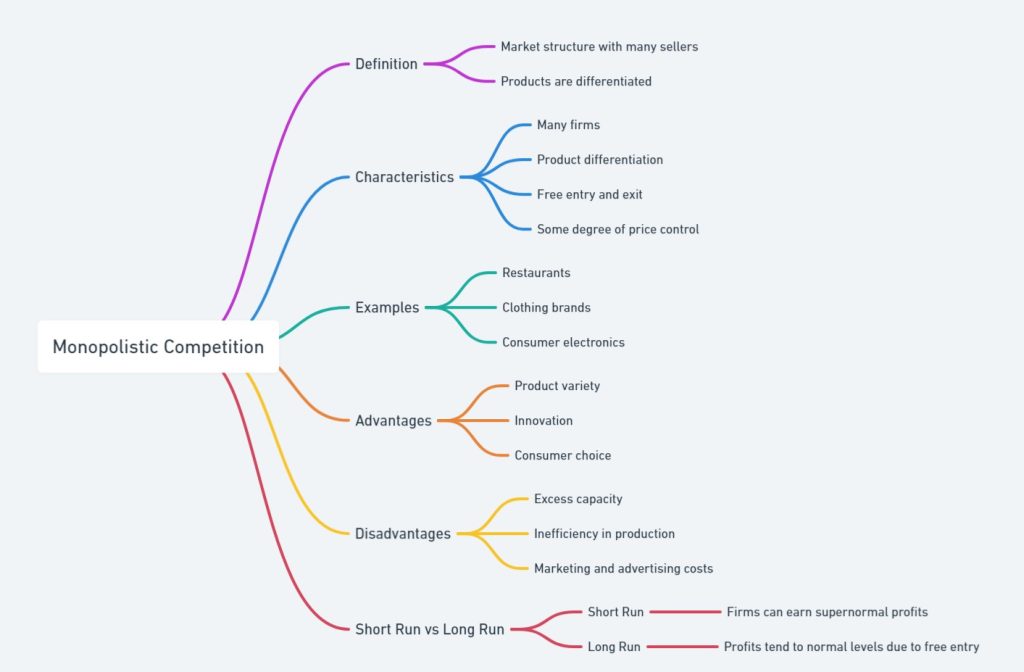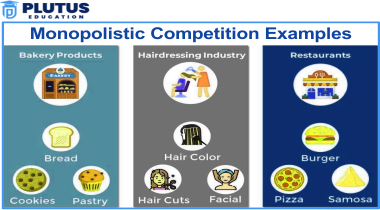Since several firms sell relatively differentiated, although non-identical products, this market structure therefore possesses some level of market power. What makes monopolistic competition special and hence an essential concept in economics is that this market combines the presence of many competitors with product differentiation. In an economic scenario, perfect competition and monopoly can fight for either or both to be the preferred form of market structure. However, as far as monopolistic competition is concerned, rivalry among different firms arises because firms differentiate their products to attract buyers but have to contend with the competition of their rival counterparts as well.
Chains of fast foods, clothing in retail malls, and consumer electronics are some common examples of monopolistic competition. Each firm would like to brand and distinguish its offerings by quality, packaging, and services, thereby ensuring dynamic competition amongst the same firms.

What is Monopolistic Competition?
Monopolistic competition In monopolistic competition, there exist numerous firms offering nearly but not the same product. Unlike perfect competition, however, they have some degree of pricing power because of the existence of variations in what they offer. On the other hand, there cannot exist very high prices for monopolistic competition such that similar substitutes are not offering them. It is mainly because consumers make their choices on purchase decisions based on considerations like quality, branding, and convenience, apart from price.
Key Features of Monopolistic Competition
- Numerous Sellers: A number of small and medium-sized firms compete without any one firm dominating the market.
- Product Differentiation: Each company is offering a product that is different in some attribute, such as style, packaging, or flavor.
- Pricing Power: Firms have some degree of price power but are controlled by the presence of close substitutes.
- High Advertising Cost: Heavy investment in advertising and marketing to establish brand identity.
- Ease of Entry and Exit: New firms are allowed easy entry, but more difficult is the process of producing a differentiable product that captures market share.
Characteristics of Monopolistic Competition
Monopolistic competition displays a combination of competitive and monopoly-like traits. Here’s a breakdown of the key characteristics:
1. Product Differentiation
Each business has a product with slight variations that appeal to different pieces of the customers. Differing variations can relate to quality, branding, design, location, and packaging. Consider the example of two coffee shops selling cappuccinos. Even though both can refer to the same thing, each will have its taste, environment, or experience service for customers.
2. Large Number of Firms
There are so many firms within the market that no one firm has its way with the whole market, and this will allow customers to easily switch between alternatives if prices rise or product quality deteriorates.
3. Independent Decision-Making
Each firm operates independently and determines its prices and production levels based on market conditions and costs. However, competitors closely monitor each other to remain competitive.
4. Free Entry and Exit
Competition forces firms to enter markets only if they foresee profit potential. On the contrary, underperforming firms can easily exit the market with less trouble. Example, when a new bakery opens in a locality, it attracts more and more customers, but if it fails to create any niche for itself, then it cannot sustain business.
5. Downward-Sloping Demand Curve
The downward-sloping demand curve reflects what firms face, given that the higher price will discourage customers from buying because they can always opt for the competitor’s offering. The curve, therefore, represents the firm’s ability to charge slightly different prices from the rivals due to product differentiation.
Advantages of Monopolistic Competition
- Product Variety: Consumers have a wide assortment of products created for their needs, which gives them choices in the price, quality, and brands they wish to purchase. For example, it puts hundreds of shampoo brands with various ingredients and benefits.
- Innovation and Novelty: Firms ought to innovate to keep up with the competition, hence offering their customers better products and services, which often involves launching new products, packaging, and technological improvements.
- Flexible Pricing: Companies are free to set their pricing according to their positioning, be it a premium product versus an option that is more of a budget choice.
- Consumer Loyalty: Branding that makes sense results in consumer loyalty and repeat purchases. For instance, fans of coffee brands are willing to pay a little extra for their products.
Disadvantages of Monopolistic Competition
- High Advertising Costs: Firms often spend heavily on marketing to differentiate products, which may increase the final product price. For example, clothing brands use extensive advertising campaigns, increasing operational costs.
- Inefficiency in Production: Since firms operate independently and at a smaller scale, they often cannot achieve economies of scale, leading to higher average costs.
- Wasteful Competition: Multiple firms offering similar products might lead to resource wastage, as each tries to outdo the other in branding and marketing efforts.
- Limited Long-Term Profits: In the long run, profits tend to normalize as new competitors enter the market, eroding the advantage held by early entrants.

What Is Difference Between Monopolistic Competition and Perfect Competition?
| Aspect | Monopolistic Competition | Perfect Competition |
|---|---|---|
| Product Type | Differentiated products | Homogeneous products |
| Market Power | Some pricing power due to differentiation | No pricing power; firms are price takers |
| Entry and Exit | Free, but product differentiation creates a barrier | Completely free with no obstacles |
| Advertising | Heavy advertising | Minimal advertising |
| Examples | Restaurants, clothing brands | Agricultural markets |
How Does Monopolistic Competition Function in the Short Term and Long Term?
Short-Term Dynamics
Product differentiation enables firms to earn economic profits in the short run. Firms use different pricing techniques, advertising, etc., to gain market share. Its demand curve is negatively sloping.
Example: A new restaurant may attract customers through innovative dishes and promotions initially, hence earning a good profit.
Long-Term Dynamics
Short-term profits attract new entrants into the market, thereby increasing competition. More and more firms entering the market cause the demand curve to shift to the left, and again, profits normalize to an equilibrium where firms only earn normal profits.
Example: If several new restaurants kept opening in the same area, then the profits for the original restaurant would decline.
Difference Between Monopolistic Competition and a Monopoly
| Aspect | Monopolistic Competition | Monopoly |
|---|---|---|
| Number of Firms | Many | One firm dominates |
| Product Differentiation | Differentiated products | Unique product with no substitutes |
| Market Entry | Easy entry and exit | Significant barriers to entry |
| Pricing Power | Limited by competition | High pricing power |
| Examples | Coffee shops, clothing stores | Utility companies |
Conclusion
Monopolistic competition offers a realistic framework for understanding the behavior of firms in everyday markets. It allows consumers to enjoy product variety and encourages firms to innovate continuously. However, the need to differentiate products often leads to inefficiencies and higher costs. In the long run, profits normalize as more firms enter the market, creating a balance between innovation and competition. Businesses operating in monopolistic competition must strategically balance their product offerings, pricing, and marketing efforts to remain sustainable.
Monopolistic Competition FAQs
Why do firms invest heavily in advertising under monopolistic competition?
Advertising helps firms build brand identity, enabling them to differentiate their products and gain customer loyalty.
What are some examples of industries operating under monopolistic competition?
Industries such as restaurants, retail clothing, and beauty products are good examples of monopolistic competition.
Can firms earn long-term profits in monopolistic competition?
No, in the long run, profits normalize due to the entry of new competitors, leading to only normal profits.
How does monopolistic competition benefit consumers?
Consumers benefit from product variety and innovation, although they may face higher prices due to advertising costs.
What differentiates monopolistic competition from oligopoly?
While monopolistic competition involves many small firms offering differentiated products, oligopoly is characterized by a few dominant players.


